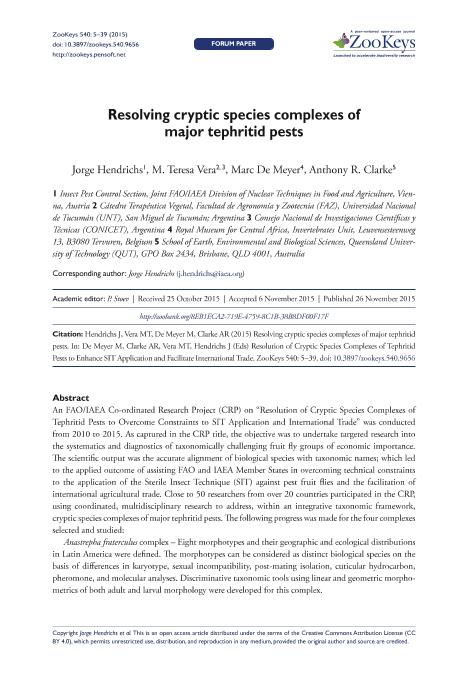Mostrar el registro sencillo del ítem
dc.contributor.author
Hendrichs, Jorge
dc.contributor.author
Vera, Maria Teresa

dc.contributor.author
de Meyer, Marc
dc.contributor.author
Clarke, Anthony R.
dc.date.available
2017-02-07T20:56:50Z
dc.date.issued
2015-11
dc.identifier.citation
Hendrichs, Jorge; Vera, Maria Teresa; de Meyer, Marc; Clarke, Anthony R.; Resolving cryptic species complexes of major tephritid pests; Pensoft Publishers; Zookeys; 540; 11-2015; 5-39
dc.identifier.issn
1313-2989
dc.identifier.uri
http://hdl.handle.net/11336/12699
dc.description.abstract
An FAO/IAEA Co-ordinated Research Project (CRP) on “Resolution of Cryptic Species Complexes of Tephritid Pests to Overcome Constraints to SIT Application and International Trade” was conducted from 2010 to 2015. As captured in the CRP title, the objective was to undertake targeted research into the systematics and diagnostics of taxonomically challenging fruit fly groups of economic importance. The scientific output was the accurate alignment of biological species with taxonomic names; which led to the applied outcome of assisting FAO and IAEA Member States in overcoming technical constraints to the application of the Sterile Insect Technique (SIT) against pest fruit flies and the facilitation of international agricultural trade. Close to 50 researchers from over 20 countries participated in the CRP, using coordinated, multidisciplinary research to address, within an integrative taxonomic framework, cryptic species complexes of major tephritid pests. The following progress was made for the four complexes selected and studied:
Anastrepha fraterculus complex – Eight morphotypes and their geographic and ecological distributions in Latin America were defined. The morphotypes can be considered as distinct biological species on the basis of differences in karyotype, sexual incompatibility, post-mating isolation, cuticular hydrocarbon, pheromone, and molecular analyses. Discriminative taxonomic tools using linear and geometric morphometrics of both adult and larval morphology were developed for this complex.
Bactrocera dorsalis complex – Based on genetic, cytogenetic, pheromonal, morphometric, and behavioural data, which showed no or only minor variation between the Asian/African pest fruit flies Bactrocera dorsalis, B. papayae, B. philippinensis and B. invadens, the latter three species were synonymized with B. dorsalis. Of the five target pest taxa studied, only B. dorsalis and B. carambolae remain as scientifically valid names. Molecular and pheromone markers are now available to distinguish B. dorsalis from B. carambolae.
Ceratitis FAR Complex (C. fasciventris, C. anonae, C. rosa) – Morphology, morphometry, genetic, genomic, pheromone, cuticular hydrocarbon, ecology, behaviour, and developmental physiology data provide evidence for the existence of five different entities within this fruit fly complex from the African region. These are currently recognised as Ceratitis anonae, C. fasciventris (F1 and F2), C. rosa and a new species related to C. rosa (R2). The biological limits within C. fasciventris (i.e. F1 and F2) are not fully resolved. Microsatellites markers and morphological identification tools for the adult males of the five different FAR entities were developed based on male leg structures.
Zeugodacus cucurbitae (formerly Bactrocera (Zeugodacus) cucurbitae) – Genetic variability was studied among melon fly populations throughout its geographic range in Africa and the Asia/Pacific region and found to be limited. Cross-mating studies indicated no incompatibility or sexual isolation. Host preference and genetic studies showed no evidence for the existence of host races. It was concluded that the melon fly does not represent a cryptic species complex, neither with regard to geographic distribution nor to host range. Nevertheless, the higher taxonomic classification under which this species had been placed, by the time the CRP was started, was found to be paraphyletic; as a result the subgenus Zeugodacus was elevated to genus level.
dc.format
application/pdf
dc.language.iso
eng
dc.publisher
Pensoft Publishers

dc.rights
info:eu-repo/semantics/openAccess
dc.rights.uri
https://creativecommons.org/licenses/by-nc-sa/2.5/ar/
dc.subject
Anastrepha Fraterculus
dc.subject
Bactrocera Carambolae
dc.subject
Bactrocera Dorsalis
dc.subject
Ceratitis Anonae
dc.subject.classification
Otras Ciencias Agrícolas

dc.subject.classification
Otras Ciencias Agrícolas

dc.subject.classification
CIENCIAS AGRÍCOLAS

dc.title
Resolving cryptic species complexes of major tephritid pests
dc.type
info:eu-repo/semantics/article
dc.type
info:ar-repo/semantics/artículo
dc.type
info:eu-repo/semantics/publishedVersion
dc.date.updated
2017-02-07T17:51:30Z
dc.identifier.eissn
1313-2970
dc.journal.volume
540
dc.journal.pagination
5-39
dc.journal.pais
Bulgaria

dc.journal.ciudad
Sofia
dc.description.fil
Fil: Hendrichs, Jorge. Joint FAO/IAEA Division of Nuclear Techniques in Food and Agriculture; Austria
dc.description.fil
Fil: Vera, Maria Teresa. Universidad Nacional de Tucumán. Facultad de Agronomía y Zootecnia. Cátedra. Terapéutica Vegetal; Argentina. Consejo Nacional de Investigaciones Científicas y Técnicas; Argentina
dc.description.fil
Fil: de Meyer, Marc. Royal Museum for Central Africa; Bélgica
dc.description.fil
Fil: Clarke, Anthony R.. Queensland University of Technology; Australia
dc.journal.title
Zookeys

dc.relation.alternativeid
info:eu-repo/semantics/altIdentifier/doi/https://doi.org/10.3897/zookeys.540.9656
dc.relation.alternativeid
info:eu-repo/semantics/altIdentifier/url/http://zookeys.pensoft.net/articles.php?id=6956
Archivos asociados
